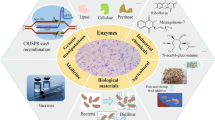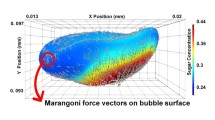Abstract
We report the first controlled measurements of expansion rates for swarming colonies of Serratia liquefaciens under different growth conditions, combined with qualitative observations of the organization of the colony into regions of differentiated cell types. Significantly, the results reveal that swarming colonies of S. liquefaciens can have an increasing expansion rate with time. We compare and contrast the expansion rate results with predictions from a recent mathematical model which coupled key hydrodynamical and biological mechanisms. Furthermore, we investigate whether the swarming colonies grow according to a power law or exponentially (for large times), as suggested by recent theoretical results.
Similar content being viewed by others
References
Ammendola, A., O. Geisenberger, J. B. Andersen, M. Givskov, K. H. Schleifer and L. Eberl (1998). Serratia liquefaciens swarm cells exhibit enhanced resistance to predation by tetrahymena sp. FEMS Microbiol. Lett. 164, 69.
Aronson, D. G. (1986). The porous media equation, in Nonlinear Diffusion Problems, A Fasano and M. Primicerio (Eds), Berlin: Springer.
Bees, M. (2002). Expansion rates for colonies of swarming bacteria in thin films. Unpublished.
Bees, M., P. Andresén, E. Mosekilde and M. Givskov (2000). The interaction of thin-film flow, bacterial swarming and cell differentiation in colonies of Serratia liquefaciens. J. Math. Biol. 40, 27.
Ben-Jacob, E. (1997). From snowflake formation to growth of bacterial colonies. II. Cooperative formation of complex bacterial patterns. Contemp. Phys. 38, 205.
Ben-Jacob, E., I. Cohen, O. Shochet, I. Aranson, H. Levine and L. Tsimring (1995). Complex bacterial patterns. Nature 373, 566.
Ben-Jacob, E., O. Shochet, A. Tenebaum, I. Cohen, A. Czirók and T. Vicsek (1994). Generic modeling of cooperative growth patterns in bacterial colonies. Nature 368, 46.
Brenner, M. and A. Bertozzi (1993). Spreading of droplets on a solid surface. Phys. Rev. Lett. 71, 593.
Budrene, E. O. and H. C. Berg (1995). Dynamics of formation of symmetrical patterns by chemotactic bacteria. Nature 376, 49.
Clark, J. D. and O. Maaløe (1967). DNA replication and the cell cycle in Escherichia coli. J. Mol. Biol. 23, 99.
Czirok, A., M. Matsushita and T. Vicsek (2001). Theory of periodic swarming of bacteria: application to Proteus mirabilis. Phys. Rev. E 6303, 1915.
de Gennes, P. G. (1985). Wetting: statics and dynamics. Rev. Mod. Phys. 57, 827.
Eberl, L., G. Christiansen, S. Molin and M. Givskov (1996a). Differentiation of Serratia liquefaciens into swarm cells is controlled by the expression of the flhD master operon. J. Bacteriol. 178, 554.
Eberl, L., S. Molin and M. Givskov (1999). Surface motility in Serratia liquefaciens. Review article. J. Bacteriol. 181, 1703.
Eberl, L., M. K. Winson, C. Sternberg, G. S. A. B. Stewart, G. Christiansen, S. R. Chabra, B. Bycroft, P. Williams, S. Molin and M. Givskov (1996b). Involvement of N-acyl-L-homoserine lactone autoinducers in controlling the multicellular behavior of Serratia liquefaciens. Mol. Microbiol. 20, 127.
Esipov, S. E. and J. A. Shapiro (1998). Kinetic model of Proteus mirabilis swarm colony development. J. Math. Biol. 36, 249.
Fujikawa, H. and M. Matsushita (1989). Fractal growth of Bacillus subtilis on agar plates. J. Phys. Soc. Japan 58, 3857.
Givskov, M., L. Eberl, G. Christiansen, M. J. Benedick and S. Molin (1995). Induction of phospholipase and flagellar synthesis in Serratia liquefaciens is controlled by expression of the flagellar master operon FlhD. Mol. Microbiol. 15, 445.
Givskov, M., L. Eberl and S. Molin (1997). Control of exoenzyme production, motility and cell differentiation in Serratia liquefaciens. FEMS Microbiol. Lett. 148, 115.
Givskov, M., L. Olsen and S. Molin (1988). Cloning and expression in Escherichia coli of the gene for an extracellular phospholipase from Serratia liquefaciens. J. Bacteriol. 170, 5855.
Givskov, M., J. Östling, L. Eberl, P. W. Lindum, A. B. Christensen, G. Christiansen, S. Molin and S. Kjelleberg (1998). Two separate regulatory systems participate in control of swarming motility of Serratia liquefaciens MG1. J. Bacteriol. 180, 742.
Golding, I., Y. Kozlovsky, I. Cohen and E. Ben-Jacob (1998). Studies of bacterial branching growth using reaction-diffusion models for colonial development. Physica A 260, 510.
Gygi, D., M. M. Rahman, H.-C. Lai, R. Carlson, J. Guard-Petter and C. Hughes (1995). A cell surface polysaccharide that facilitates rapid population migration by differentiated swarm cells of Proteus mirabilis. Mol. Microbiol. 17, 1167.
Henrichsen, J. (1972). Bacterial surface translocation: a survey and a classification. Bacteriol. Rev. 36, 478.
King, J. R. (2001). Thin-film flows and high-order degenerate parabolic equations, IUTAM Symposium on Free Surface Flows, A. C. King and Y. D. Shikhmurzaev (Eds), Dordrecht: Kluwer.
Kitsunezaki, S. (1997). Interface dynamics for bacterial colony formation. J. Phys. Soc. Japan 66, 1544.
Kozlovsky, Y., I. Cohen, I. Golding and E. Ben-Jacob (1999). Lubricating bacteria model for branching growth of bacterial colonies. Phys. Rev. E 59, 7025.
Lacasta, A. M., I. R. Cantalapiedra, C. E. Auguet, A. Penaranda and L. Ramirez-Piscina (1999). Modeling of spatiotemporal patterns in bacterial colonies. Phys. Rev. E 59, 7036.
Li, B., J. Wang, W. Liu and Z. Wu (1995). Computer simulations of bacterial colony formation. Europhys. Lett. 30, 239.
Lindum, P. W., U. Anthoni, C. Christoffersen, L. Eberl, S. Molin and M. Givskov (1998). N-acyl-L-homoserine lactone autoinducers control production of an extracellular surface active lipopeptide required for swarming motility of Serratia liquefaciens MG1. J. Bacteriol. 180, 6384.
Matsushita, M., J. Wakita, H. Itoh, I. Rafols, T. Matsuyama, H. Sakaguchi and M. Mimura (1998). Interface growth and pattern formation in bacterial colonies. Physica A 249, 517.
Matsuyama, T. and M. Matsushita (1996). Morphogenesis by bacterial cells, in Fractal Geometry in Biological Systems, P. M. Iannaccone and M. Khokha (Eds), Boca Raton, FL: CRC Press.
Matsuyama, T., M. Sogawa and Y. Nakagawa (1989). Fractal spreading growth of S. marcescens which produces surface active exolipids. FEMS Microbiol. Lett. 61, 243.
McCarter, L., M. Hilmen and M. Silvermen (1988). Flagellar dynamometer controls swarmer cell-differentiation of V. parahaemolyticus. Cell 54, 345.
Rasmussen, T. B., M. Manefield, J. B. Andersen, L. Eberl, U. Anthoni, C. Christophersen, P. Steinberg, S. Kjelleberg and M. Givskov (2000). How Delisea pulchra furanones affect quorum-sensing and swarming motility in Serratia liquefaciens MG1. Microbiology 146, 3237.
Rasmussen, T. B., T. T. Nielsen, L. Eberl, M. A. Bees, S. Molin and M. Givskov (2002). Surface conditioning in a swarming colony: cells have different assignments. Microbiology submitted.
Rauprich, O., M. Matsushita, C. J. Weijer, F. Siegert, S. E. Esipov and J. A. Shapiro (1996). Periodic phenomena in P. mirabilis swarm colony development. J. Bacteriol. 178, 6525.
Shapiro, J. A. (1995). The significance of bacterial colony patterns. Bioessays 17, 597.
Shikhmurzaev, Y. D. (1997). Spreading of drops on solid surfaces in a quasi-static regime. Phys. Fluids 9, 266.
Tolker-Nielsen, T., A. B. Christensen, L. Eberl, T. B. Rasmussen, C. Sternberg, S. Molin and M. Givskov (2000). Assessment of flhDC mRNA levels in individual Serratia liquefaciens swarm cells. J. Bacteriol. 182, 2680.
Woodward, D. E., R. Tyson, M. R. Myerscough, J. D. Murray, E. O. Budrene and H. C. Berg (1995). Spatial temporal patterns generated by Salmonella typhimurium. Biophysical J. 68, 2181.
Author information
Authors and Affiliations
Rights and permissions
About this article
Cite this article
Bees, M.A., Andresén, P., Mosekilde, E. et al. Quantitative effects of medium hardness and nutrient availability on the swarming motility of Serratia liquefaciens . Bull. Math. Biol. 64, 565–587 (2002). https://doi.org/10.1006/bulm.2002.0287
Received:
Accepted:
Issue Date:
DOI: https://doi.org/10.1006/bulm.2002.0287




